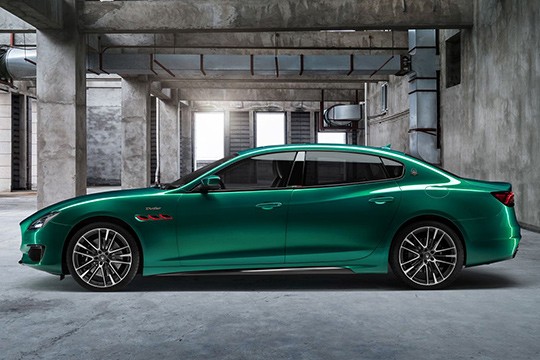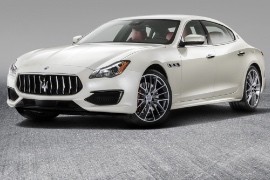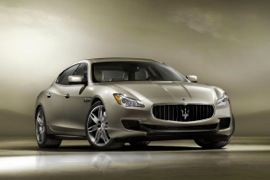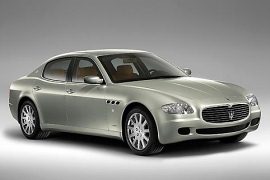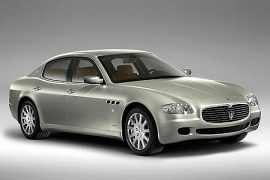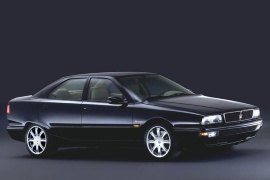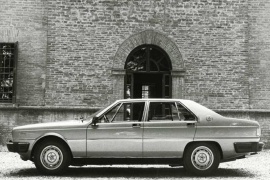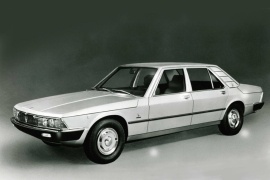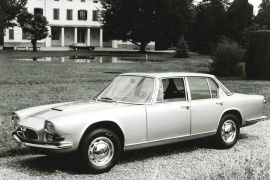MASERATI Quattroporte Models/Series Timeline, Specifications & Photos
First production year: 1963
Engines: Gasoline, Diesel
In August 2020, Maserati presented its new Trofeo (Trophy) lineup for the Ghibli, the Quattroporte, and the Levante. All three of them shared the same Ferrari twin-turbo V8 engine.
Maserati was in constant evolution in 2020, despite the hard times caused by the world pandemic situation. It launched new models, such as the MC20 supercar, and a more powerful version for its four-door models. The Quattroporte was their flagship, the car that was built for Italian CEOs. The Trofeo version was the fastest version of it.
From the outside, the Trofeo looked similar to the regular Quattroporte, but some details made a difference. At the front, the car featured a different bumper and apron design, with a wider center grille and modified side-scoops to cool the brakes. From the side, the front fenders featured three vents with red trims and the Trofeo badge. On the C-pillars, under the brand's badge, a red stripe was installed.
Inside, the Trofeo was fitted with the best amenities available in the Maserati storage. The instrument cluster featured a TFT color display between the speedometer and the tachometer. The infotainment system was fitted with a big touch-screen on the center stack. To complete the sporty character of the car, carbon-fiber trims were installed on the dashboard and the center console.
But the real update was on the technological side. A 3.8-liter V8 engine was placed under the hood and paired to an 8-speed automatic transmission. Power went to the rear wheels only, via a standard limited-slip differential. For better control of the 580 hp, the Quattroporte Trofeo was fitted with an Integrated Vehicle Control (IVC) system, tuned for enhanced vehicle dynamics, and better active safety.
The sixth generation of the Maserati Quattroporte was introduced in 2013. Three years later, the four-door executive sedan received a major upgrade.
Maserati is not just another brand. It is the four-door version of a Ferrari and that is backed up by its Ferrari engines and the emotional design. The first generation of the Quattroporte (four-door) was introduced in 1963 and evolved ever since. The Italian car-manufacturer tried to offer as much luxury as possible in a car that could match the pace of a supercar and still offer the comfort of an executive sedan.
The facelift introduced a new grille design with vertical chromed slats. There was a new design for the front and rear bumpers, and matte black side sills. The aggressive stance of the car was enhanced and offered a sportier look for the GranSport version, with the introduction of carbon-fiber details. The GranLusso featured more chromed elements in the front bumper.
Inside, there was a new dashboard with an integrated 8.4” with touch controls. A new set of controls for the climate control unit was installed. For the interior, the Italian car maker worked closely with the famous fashion designer Ermenegildo Zegna and offered a 100 units, limited edition, Zegna, which featured 100% silk in the seats, an leather side bolsters and a few other unique exterior details.
For the drivetrain, the Quattroporte retained the three engine versions as before, with a 3.0-liter V6, a 3.8-liter V8, and a diesel V6. All versions were turbocharged, and the gasoline engines were supplied by Maserati's parent company, Ferrari.
When it comes to luxury and fine tastes, it was hard to beat the Italians, and that was obvious on the sixth generation of Maserati's flagship, the Quattroporte.
The Quattroporte was always a sporty sedan, regardless of the engine under the hood. The sixth-generation couldn't be different than its predecessors, and it wasn't. In fact, it was even better than them adding more power, more features, and more comfort to Maserati's flagship.
It was designed in Centro Stile FCA without any help from Pininfarina or Bertone. The company already had the experience and the staffing to make great-looking cars. Quattroporte's streamlined bodywork, with wave-like beltline and cab-rearward concept, inspired a sports car with four doors. At the front, the boomerang-style headlights resembled those installed on the rest of the range, while the black grille with vertical slats resembled older race cars from the company's history. On the front fenders, the carmaker installed three vents on each side. In the back, the quad-exhaust system with a rectangular profile popped out through the rear apron, while an integrated spoiler enhanced the short trunk lid.
Inside, Maserati prepared a leather-clad interior with comfortable seats. Depending on the trim level, the carmaker installed wood or carbon-fiber trims on the dashboard, door panels, and center console. A large intuitive touch-screen covered most of the center stack. In the back, Maserati offered either a bench for three or two individual seats. Thanks to its big wheelbase, the car provided plenty of legroom even for six-footers (over 2 m height).
Under the hood, Maserati installed a choice of three engines ranged between a 275 hp turbo-diesel and a 530 hp turbocharged V-8.
The fifth generation of the Maserati Quattroporte was unveiled in 2003 at the Frankfurt Motor Show. Five years later, at the 2008 Geneva Motor Show, was launched the facelift version.
The Quattroporte S was revealed and offered more luxury and revised exterior features. It was a true Grand Turismo vehicle, but with four doors. But being built by Maserati, it was a normal step and it was comfortable enough for four passengers, unlike most of the GT vehicles on the market which are good only for two.
The flowing, aerodynamic, shape of the Quattroporte was designed by Ken Okuyama at the Pininfarina studio. Its big and low grille, new Xenon headlights, and LED daytime running lights enhanced the front fascia. The raked A-pillars mimicked a sports car. The three vents on the front fenders and curved beltline confirmed the car's appeal for sport. The small, triangular, taillights were designed with the U.S. market in mind, where the brake-lights had to be mounted on a fixed body panel. There was no light on the trunk lid.
Inside, the Quattroporte featured a luxurious interior, with improved leather seats, new wood trim on the dashboard, and center stack. The infotainment unit was not that big as it was used for other premium car-makers from that time. The steering wheel featured several buttons for various functions. The comfortable front seats and the rear profiled bench were designed for comfort, not for sporty driving.
Under the hood, the Quattroporte S was offered with a newly developed 4.7-liter V8 engine. It produced 40 hp more than its predecessor and it was mated as standard to a 6-speed automatic transmission developed by ZF. The former automated gearbox was ditched due to its reliability issues.
The fifth generation of the Maserati Quattroporte was unveiled in 2003 at the Frankfurt Motor Show. It was a two-year gap after the last, fourth generation, Quattroporte rolled out from the factory.
The wait worth it. The new sport-executive car was not only faster, but it looked way better. Its predecessor was designed in the '90s and it was outdated. The 2003 Quattroporte had the four-door configuration from Maserati and an engine designed by Ferrari.
The flowing, aerodynamic, shape of the Quattroporte was designed by Ken Okuyama at the Pininfarina studio. Its big and low grille, small headlights, and raked A-pillars mimicked a sports car. The three vents on the front fenders and curved beltline confirmed the car's appeal for sport. The small, triangular, taillights were designed with the U.S. market in mind, where the brake-lights had to be mounted on a fixed body panel. There was no light on the trunk lid.
Inside, the Quattroporte featured a luxurious interior, with leather seats, wood trim on the dashboard, and the center stack. The infotainment unit was not that big as it was used for other premium car-makers from that time. The steering wheel featured several buttons for various functions. The comfortable front seats and the rear profiled bench were designed for comfort, not for sporty driving.
Under the hood, the Quattroporte was offered with only one engine option, a 4.2-liter V8 naturally aspirated engine. It was mated as standard to a 6-speed manual, while a 6-speed automatic was on the options list. In that segment, the manual gearbox was not that common anymore.
Maserati introduced a successor for the Quattroporte after four years since the last of the third-generation model rolled out from the assembly lines.
Alejandro de Tomaso sold his stakes in Maserati to Fiat, and the Italian company decided to continue the Quattroporte and offered it as a premium sports sedan. It was, more or less, a stretched, four-door version of the Maserati Biturbo.
Fiat selected Marcello Gandini to design the car. He kept the same wedged shapes from the Biturbo and Shamal models. It featured horizontal, rectangular headlights instead of the four squared headlamps use on its predecessor. The wrapped-around plastic bumpers sported the fog lights on the lower side. He penned a clean and ascending line on the upper side of the wheel-arches, following the same design idea from the Shamal, which was introduced four years earlier.
Inside, the carmaker installed a luxurious, leather-clad interior. Maserati enhanced it with wood veneers on the dashboard, door panels, center stack, and center console. As a touch of excellence, the carmaker installed an oval-shaped analog clock in the middle of the dashboard. The bucket seats featured higher bolstering than most of the executive sedans from that era. In the back, Maserati offered a bench profiled for two occupants, with a folding center armrest. Due to the high transmission tunnel, it wasn't easy to sit three people there.
Under the hood, Maserati offered a choice of three engines, depending on the market. They provided between 284 hp and 336 hp, and they were paired to a five- or six-speed manual, with an option for a four-speed automatic. A 2.0-liter V-6 bi-turbo was on the offer until 1998 when the Italian carmaker introduced a facelifted version named Evoluzione.
The third generation of the Maserati Quattroporte was released under the new management of Alejandro de Tomaso and it was developed since 1976 and the production began in 1979.
Known as the Maserati Tipo AM330, the 1979 Quattroporte returned to the rear-wheel-drive system. The design was made by Giorgetto Giugiaro, who draw the car with very strong stylistic lines. The Quattroporte was used since 1983 by the Italian president Sandro Petrini and by the opera singer Luciano Pavarotti. It was one of the most successful vehicles in Maserati history by then. The pre-production model was shown at the 1976 Turin Motor Show and it was produced until 1990.
The shape was long and with straight lines, the kind of design given by Giugiaro to the vehicles it drew. Its four square headlights and the aluminum grille with the trident on it were similar to those found on other Maserati models. The greenhouse was tall enough to fit 1.85m (6 ft), tall adults, in the rear. In the back, the car was fitted with two exhausts.
Inside, the leather and wood were the main ingredients of the car. An oval clock was mounted on the dashboard and tilted toward the driver. The car was fitted with a climate control unit. In the back, depending on the options, the car was fitted with two or three seats.
Under the hood, the Quattroporte started its career with a 4.2-liter V8 engine good enough for 255 hp. It was later enhanced to a 4.9-liter unit, upgraded to a 280 hp unit. The special version Royale featured a different fuel system that allowed an increase in power of up to 300 hp. It was mated to a standard 5-speed manual. On custom order, it was available with a 3-speed automatic.
It was the only front-wheel-drive Maserati Quattroporte, and Citroen forced the Italian carmaker to make it, and the result was a financial disaster.
When Citroen owned the Italian brand, it considered that it should re-introduce the Quattroporte in the lineup. Maserati no longer produced the first generation of the four-door luxury car since 1969, and its customers were eager to get a new model, which was finally unveiled at the 1974 Paris Motor Show. It was a long, almost as heavy, four-door sedan built on top of an extended Citroen SM platform. The former V-8 engine was replaced by a V-6, which wasn't powerful enough for the Italian brand. Moreover, it was front-wheel-drive! To worsen things even more, the car didn't get European approval.
With a design signed by Marcello Gandini from Carozzeria Bertone, the 1974 Quattroporte featured a wedged-shaped bodywork with flat panels and squared headlights. Its cab-rearward look created the idea that it was a rear-wheel-drive vehicle.
Inside, the carmaker didn't make any compromise and installed a luxurious cabin. Citroen targeted the luxury car market, and due to that, it installed a spacious cabin with two wide seats at the front and a bench for three in the rear, with a folding armrest in the middle.
Citroen designed the V-6 engine with a direct fuel injection system, which was highly advanced for those times. It provided 210 hp, and it was paired with a five-speed manual gearbox developed by ZF. But the car was a total commercial failure. Maserati sold only 13 units of it. It remained the only front-wheel-drive Quattroporte built.
The first generation of the Maserati Quattroporte was introduced in 1963 at the Turin Motor Show. It was the backbone of Italian car-manufacturer in the early '60s.
When it was introduced to the market, it became the car for every Italian success entrepreneur. It was large, reliable, and comfortable with seating for four adult people inside. The big V8 engine offered a better specific power output than most of the American car-makers.
The exterior was inspired by the Maserati 5000 GT, but with a different front fascia. The four-round headlights were kept, but the grille was smaller. A straight, slightly descending side line enhanced the sporty image of the car. The slim taillights were mounted high on the back. It also featured a dual exhaust system, with the pipes mounted under the rear chromed bumper.
Inside, the Quattroporte featured a leather upholstery for the seats. The dashboard was covered in leather as well. With its floor-mounted gear stick, the car looked like it was inspired by a GT vehicle. And that it was. The instrument panel offered all the needed information regarding the engine as in a sports car. The front flat seats were designed to offer a comfortable ride.
The Quattroporte was built on a unibody steel bodywork, instead of a chassis like other luxury cars on the market. That made it a lighter vehicle. The front independent suspension featured hydraulic dampers. In the back, there were few versions of the suspension, with either a DeDion type with coil springs or a solid axle with leaf springs. There was an option for a limited-slip differential. The first models used a 4.1-liter engine which was later replaced by a more powerful 4.7-liter unit. It was the fastest sedan of its times.
